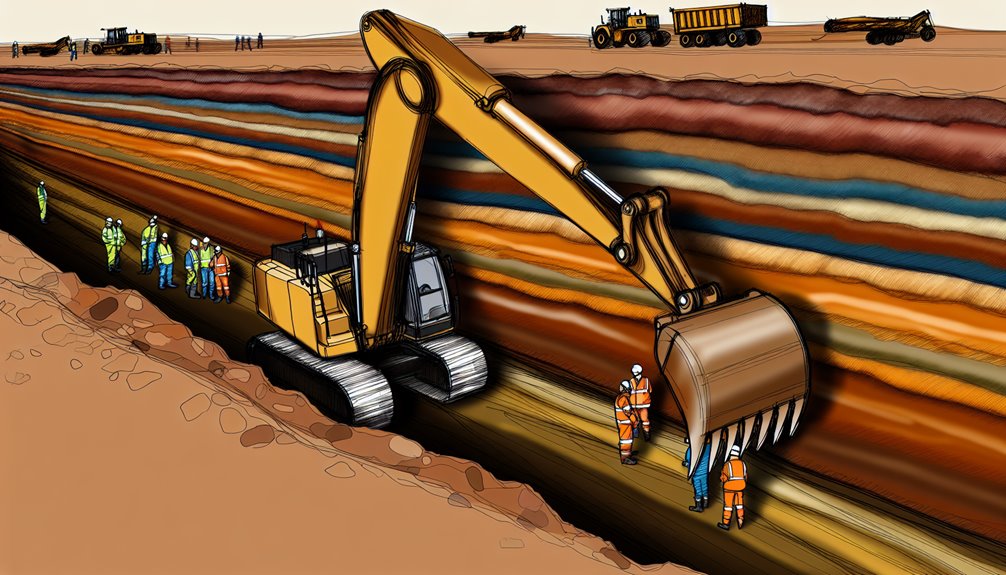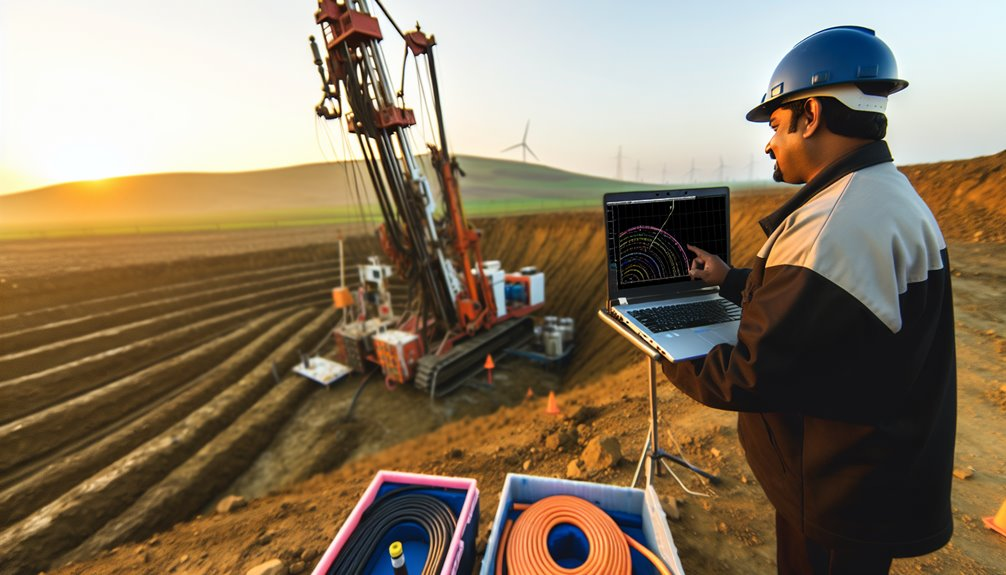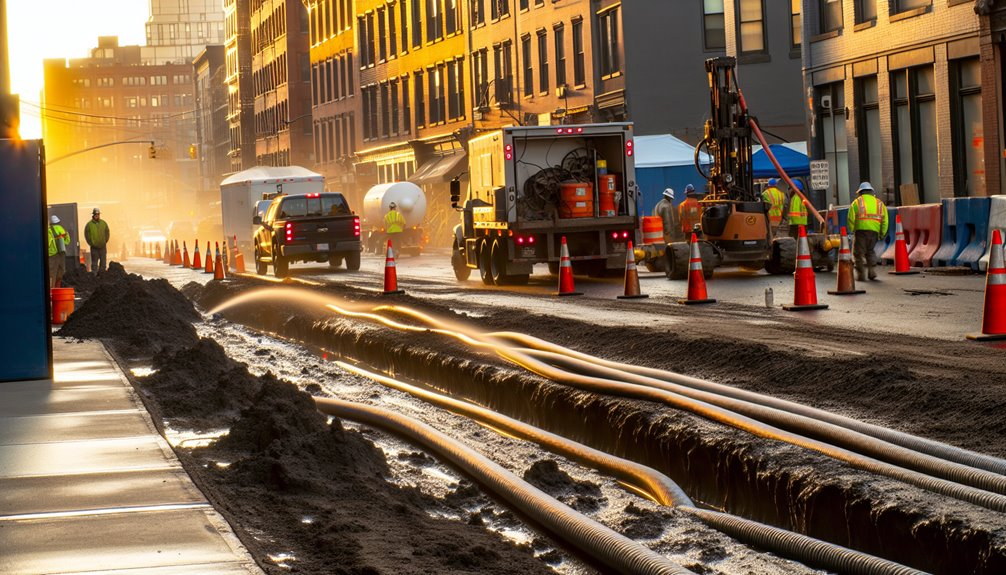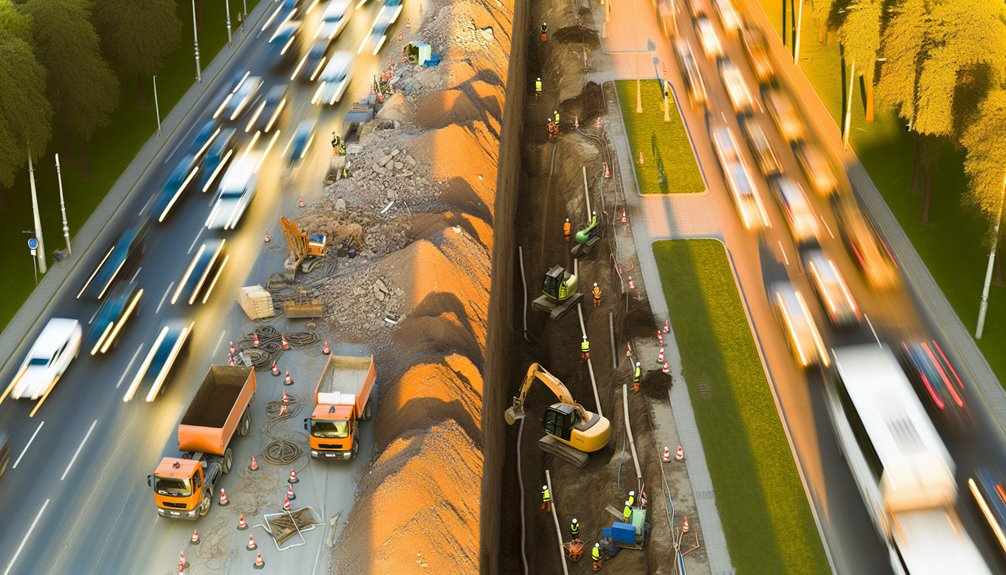As you explore the domain of trenching services, you'll find that the techniques and applications are as diverse as they are vital. Whether you're considering manual trenching with shovels and pickaxes for smaller projects or leaning towards mechanical trenchers for large-scale operations, each method offers distinct advantages and challenges. By understanding the nuances of each technique, from the precision of microtrenching in urban areas to the efficiency of horizontal directional drilling, you'll be better equipped to make informed decisions for your infrastructure needs. What's essential is recognizing the environmental impacts and implementing sustainable practices, which we'll explore next.
Understanding the Basics of Trenching
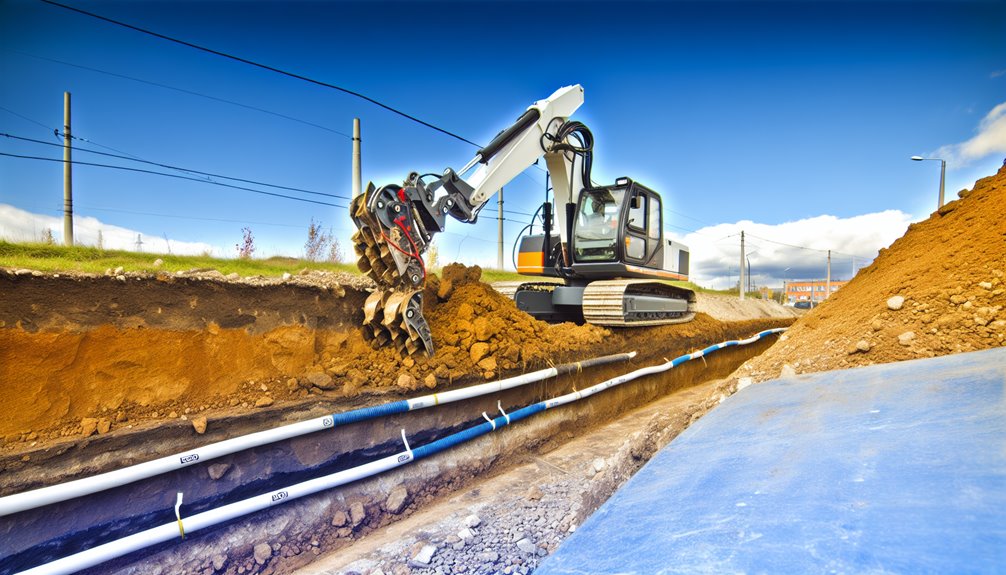
Before starting any trenching project, it's vital to conduct a thorough site survey and plan carefully. You need to assess the terrain and soil composition to determine the ideal trench design. Identifying potential obstacles is fundamental for planning an effective excavation route.
The depth and width of your trench should directly respond to the site-specific conditions, aiming to prevent any costly delays while ensuring worker and environmental safety.
When selecting excavation methods, consider the type of soil and its stability. This preliminary analysis supports your choice between wheel, chain, or micro trenchers, thereby enhancing the trenching process.
Advanced planning enables the integration of innovative trenching techniques that improve efficiency and safety, tailoring solutions to the unique challenges of each site. Proper methods ensure adherence to regulations and safety standards throughout the trenching process, minimizing risks and facilitating successful project completion.
Manual Trenching Techniques and Tools
When tackling a trenching project manually, selecting the right tools and techniques is essential for both efficiency and safety.
Opt for robust steel-bladed trenching shovels designed for narrow, deep cuts. Utilize a SharpShooter shovel for precision, and employ a trenching hoe for deeper, wider trenches using a chopping motion.
Begin with a broader trench to manage workspace effectively and leverage foot and body weight to minimize strain. Employ angled ramps with your hoe to ease gravel extraction.
Confirm your tools, featuring fiberglass handles and tempered steel blades, are regularly inspected and maintained. Adding the right accessories, such as long handles for better leverage, can significantly enhance the functionality of your trenching tools enhance the functionality.
Mechanical Trenching: Equipment and Processes
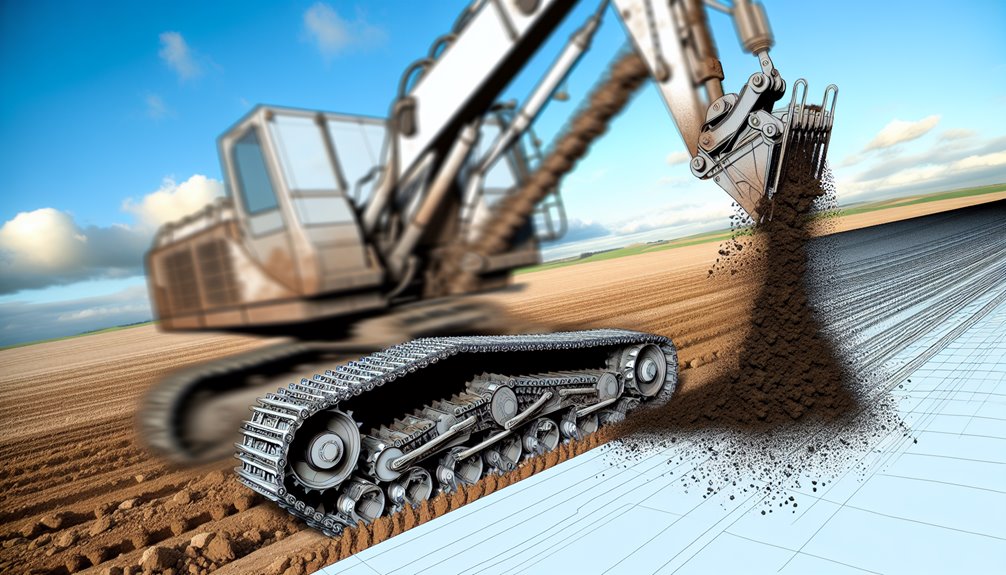
As you explore mechanical trenching, consider the variety of machines available, each tailored for specific project needs.
You'll need to familiarize yourself with operational safety protocols, which are essential to prevent accidents during the use of heavy equipment like excavators and trenchers.
Evaluating the right type of trenching machine and adhering to stringent safety measures guarantees efficiency and worker safety in your projects.
Trenching Machine Types
Trenching machines, essential for efficient and precise ground excavation, come in various types ranging from walk-behind models to ride-on units. These machines are equipped with a digging chain that features teeth or cutting blades, powered by a sophisticated hydraulic system.
This design enables you to achieve precision in digging uniform, graded trenches with consistent depth and width, greatly enhancing productivity by digging at speeds up to four times faster than traditional excavators.
However, you'll find that maintaining these trenchers is vital to sustaining their performance, especially given the harsh environments they often operate in.
Continual advancements in trenching technology not only focus on enhancing efficiency but also on improving the durability and reliability of the equipment, ensuring longevity and reducing downtime for maintenance.
Operational Safety Protocols
Before initiating any mechanical trenching project, it's vital to establish thorough operational safety protocols to mitigate risks and guarantee the safety of all personnel involved.
Embracing the latest in trenching technology and excavation innovations not only enhances efficiency but also assures compliance with safety standards.
- Hazard Identification: Regularly conduct detailed site assessments, including soil analysis and underground utility mapping, to preemptively address potential risks.
- Protective Systems: Implement advanced protective systems like hydraulic shoring and trench boxes, routinely inspected to maintain their integrity and effectiveness.
- Atmospheric Testing: Prioritize atmospheric testing to detect toxic gases or oxygen deficiencies, utilizing cutting-edge air monitoring equipment to guarantee a safe working environment.
These measures are vital in fostering a secure and productive excavation site.
Horizontal Directional Drilling: A Modern Approach
While horizontal directional drilling (HDD) might seem like a recent innovation, it has rapidly evolved into a preferred method for underground utility and infrastructure installation.
You'll find this drilling technology central in trenchless innovation, offering a streamlined approach to installing everything from utility lines to telecommunications conduits.
The process begins with pilot drilling, creating a precise initial bore path that's expanded later.
Significantly, steerable drilling technology allows for meticulous control, maneuvering under rivers and highways with minimal surface disruption.
This precision minimizes environmental impact, making HDD a go-to for projects requiring efficient, clean, and versatile installation solutions across various soil types.
Despite its complexities, the benefits of HDD, from reduced labor to environmental preservation, underscore its revolutionary impact on modern construction and infrastructure development.
Trenching Safety Protocols and Standards
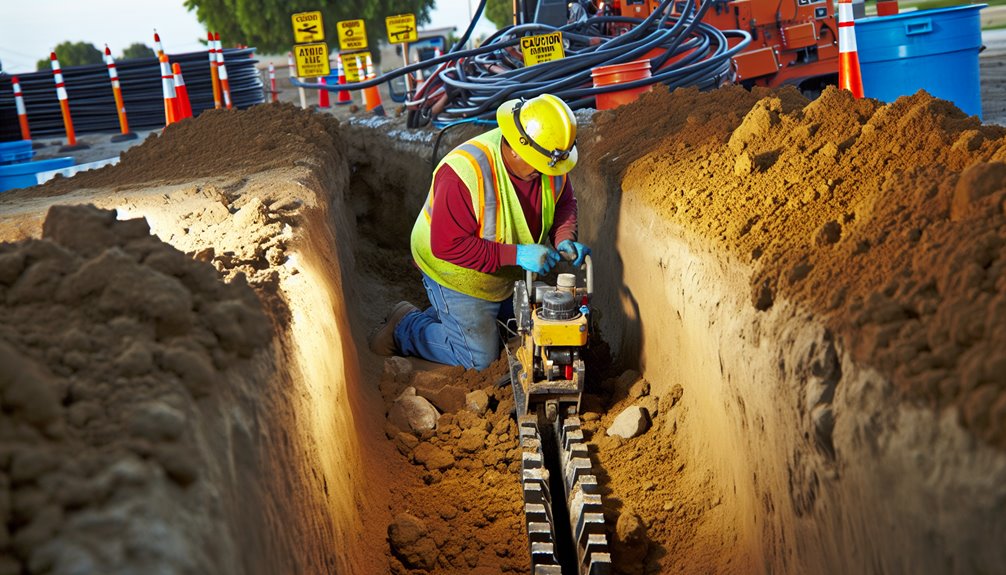
To guarantee the safety of personnel during trenching operations, stringent protocols and standards must be adhered to.
You must verify that all trenches deeper than five feet are equipped with a protective system, unless excavated in stable rock, to aid trench collapse prevention. A competent person must evaluate less deep excavations for safety without necessarily using these systems.
- Trench Collapse Prevention: Employ protective systems like shoring and shielding tailored to the soil conditions.
- Excavation Hazard Identification: A designated competent person must identify potential hazards and soil types daily.
- Protective Measures: Implement and monitor the correct use of Personal Protective Equipment (PPE) and safety gear to mitigate risks.
These measures are critical to maintaining a safe trenching environment.
Environmental Considerations in Trenching Operations
As you plan your trenching operations, it's vital to take into account strategies for minimizing habitat disruption and preventing soil erosion.
You'll need to select trenching methods that balance operational efficiency with ecological sensitivity, potentially opting for techniques that offer lower ground disturbance.
Additionally, implementing robust erosion control measures, such as sediment barriers and proper spoil placement, is essential to maintain soil stability and reduce environmental impact.
Minimizing Habitat Disruption
Before starting any trenching project, it's critical to conduct an environmental impact assessment (EIA) to identify and mitigate potential disruptions to natural habitats.
You'll prioritize habitat restoration, using ecological mapping to pinpoint sensitive areas like wetlands or wildlife habitats. This process guides your excavation, ensuring minimal impact.
To deepen your understanding, consider these key actions:
- Ecological Mapping: Identify critical habitats to avoid during planning.
- Species Relocation: Transplant endangered or sensitive species to safe areas.
- Post-Excavation Habitat Protection: Implement strategies to preserve native flora and fauna after trenching concludes.
These steps not only comply with environmental regulations but also demonstrate your commitment to innovative, responsible trenching practices that safeguard ecosystems.
Soil Erosion Prevention
When implementing trenching operations, it's vital to integrate soil erosion prevention techniques to safeguard the surrounding environment. You'll find contour trenching and berm construction particularly effective.
Trenches aligned with contours intercept water flow, while berms reinforced with native vegetation stabilize the soil. This setup not only controls erosion but also enhances soil conservation.
Employing vegetative methods, such as seeding and live staking, further protects against erosion. Structural controls like rock weirs and flumes decelerate water, minimizing soil displacement.
Regular maintenance and inspections are essential. They guarantee that erosion control measures remain effective, especially following adverse weather or adjacent construction activities.
These strategies collectively uphold environmental integrity while advancing trenching efficiency.
Applications of Trenching in Telecommunications
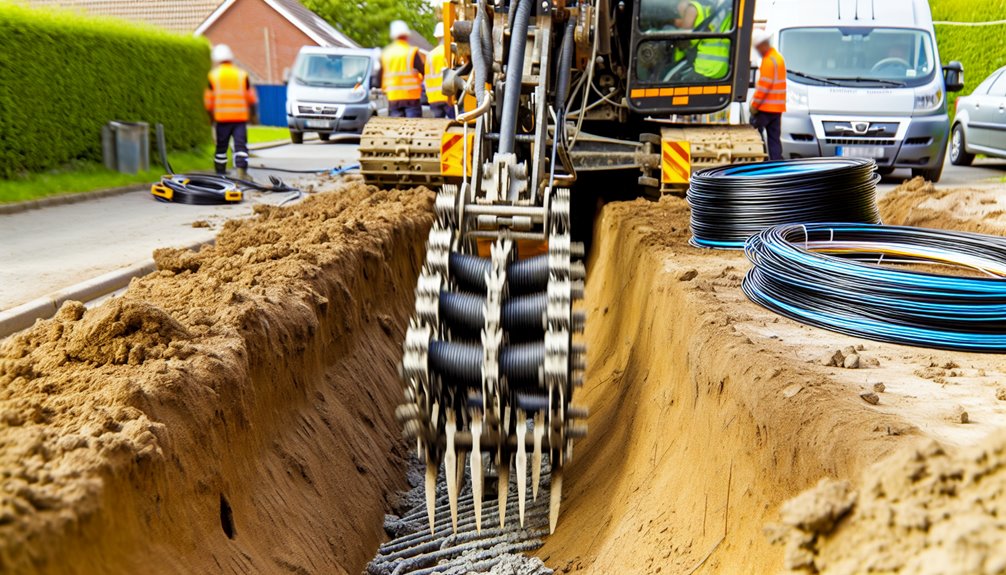
Trenching considerably enhances the efficiency and precision of telecommunications infrastructure deployment. This method is essential for quickly laying down fiber optic cables, vital for high-speed internet.
It's not just about speed; trenching also guarantees installation efficiency, important in fast-paced urban settings where disruption needs to be minimal.
- Microtrenching: Enables narrow, shallow trenches that speed up fiber optic deployments and drastically cut costs by nearly 60%.
- Precision: Trenchers dig with exact depths and widths, minimizing the need for rework and avoiding damage to existing utilities.
- Environmental and Aesthetic Preservation: Less invasive methods maintain the urban landscape's integrity and reduce ecological footprints.
This approach aligns perfectly with the innovation-driven demands of today's telecommunications industry.
Trenching for Water and Sewage Systems
As you explore trenching for water and sewage systems, it's clear that precision in the excavation process plays a vital role in guaranteeing the integrity and functionality of underground infrastructure.
Accurate trench depth is essential, not only for encasing the pipes but also for providing a protective layer atop them. This depth control, combined with meticulous slope maintenance—typically one inch per ten feet—facilitates ideal water flow and system stability, particularly in high-traffic zones.
Incorporating effective drainage solutions such as catch basins or French drains mitigates water pooling, which can severely compromise pipe integrity.
Regular inspections and adherence to safety standards guarantee that these trenches meet rigorous operational and safety criteria, sustaining the long-term viability of your water and sewage frameworks.
Conclusion
In sum, you've seen how trenching is integral to modern infrastructure. Whether you're deploying manual or mechanical techniques, or opting for horizontal directional drilling, each method demands strict adherence to safety and environmental protocols. As you engage in trenching for telecommunications or water systems, remember the importance of precision and sustainability in your practices. Embrace these advanced techniques to enhance efficiency and minimize impact, ensuring your trenching projects are both effective and responsible.
If you're curious to learn more about trenching and how we can help, I invite you to visit Boring Bros at boringbro.com. You can also give us a call at (954) 639-6167. We're here to answer any questions you may have and guide you through your trenching needs. Let's work together to make your projects a success!

